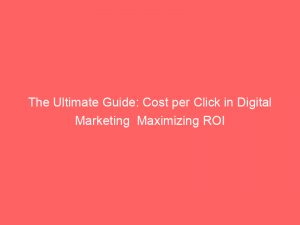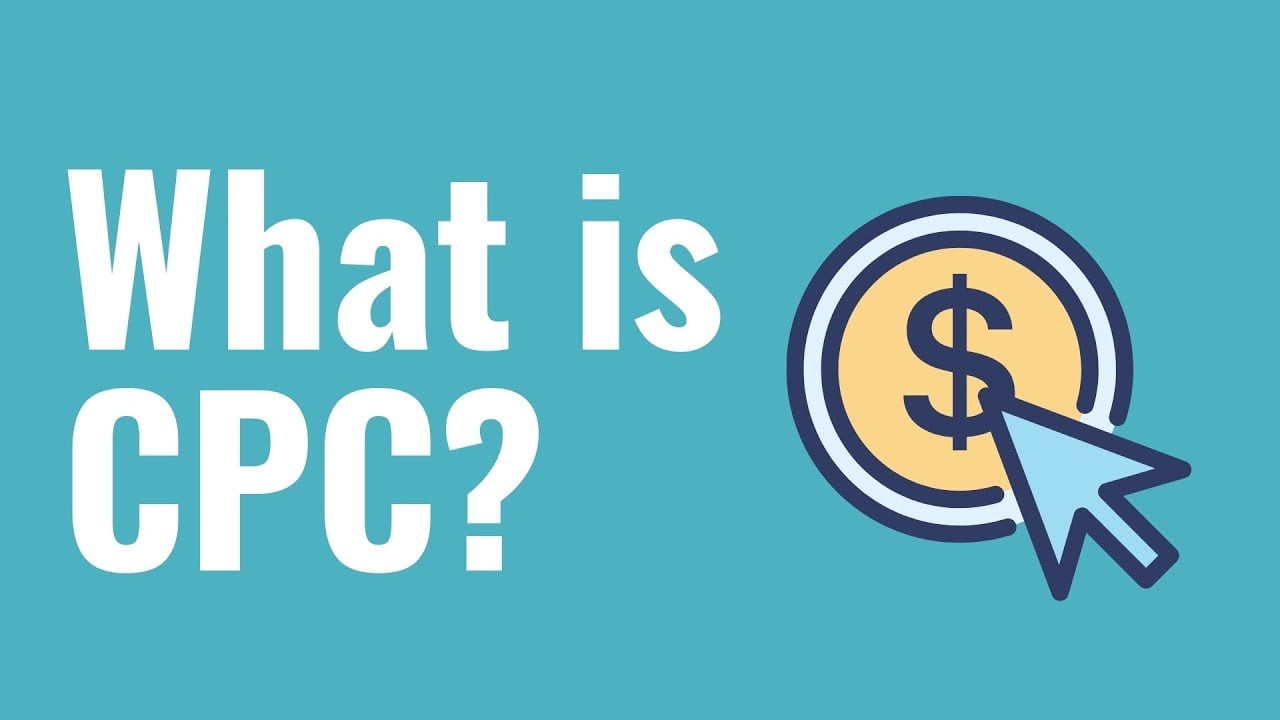In the vast digital marketing landscape, where competition is fierce and users’ attention is fleeting, every click counts. Imagine being able to pay for advertising only when someone clicks on your ad, ensuring that your budget is used efficiently and effectively.
This is where cost per click (CPC) comes into play, revolutionizing the way advertisers reach their target audience. By charging advertisers based on the number of clicks they receive, CPC offers a measurable and cost-effective approach to online advertising.
But how can you optimize your CPC? Through careful research, strategic optimization, and the use of relevant keywords, you can maximize your ad’s impact while minimizing costs.
Dive deeper into the world of CPC and discover the secrets to success in the digital marketing realm.
Table of Contents
- cost per click in digital marketing
- Introduction To Cost Per Click (CPC)
- Understanding The CPC Vs CPM Model
- Exploring Google’s AdSense Platform
- Managing CPC With Daily Budgets
- The Bidding System And Determining Click Costs
- Leveraging Google Ads Discounts With Quality Scores
- Calculating CPC Using The Advertising Campaign Cost Formula
- Key Factors Affecting CPC And Strategies To Lower Costs
cost per click in digital marketing
The cost per click (CPC) in digital marketing refers to the amount advertisers are charged for each click their ad receives. This online advertising model, also known as pay-per-click (PPC), is a popular choice for many advertisers.
CPC is determined through a bidding system, where advertisers set a maximum amount they are willing to pay for a click. Factors that affect CPC include ad rank, quality, position, user signals, search topics, and auctions.
To lower CPC, advertisers should focus on relevant keywords, improve ad quality, and consider automated bidding. The formula for calculating CPC is Advertising Campaign Cost divided by the number of clicks.
Key Points:
- Cost per click (CPC) refers to the charge advertisers pay for each click on their ad in digital marketing.
- CPC is determined through a bidding system where advertisers set a maximum amount for each click.
- Factors that influence CPC include ad rank, quality, position, user signals, search topics, and auctions.
- To decrease CPC, advertisers should focus on relevant keywords, improve ad quality, and consider automated bidding.
- The formula for calculating CPC is Advertising Campaign Cost divided by the number of clicks.
- CPC is a popular choice for advertisers due to its pay-per-click (PPC) online advertising model.
Sources
https://advertising.amazon.com/library/guides/cost-per-click
https://www.investopedia.com/terms/c/cpc.asp
https://www.businessofapps.com/ads/cpc/research/cpc-rates/
https://www.wordstream.com/cost-per-click
Check this out:
💡 Pro Tips:
1. Consider using long-tail keywords: Long-tail keywords are more specific and have lower competition, which can lead to lower CPCs. Targeting niche, specific keywords can help attract more relevant clicks at a lower cost.
2. Utilize retargeting campaigns: Retargeting allows you to advertise to users who have already shown interest in your products or services. Since these users are more likely to convert, retargeting campaigns often have lower CPCs and higher conversion rates.
3. Optimize landing pages for higher relevance: Ensuring that your landing pages are highly relevant to your ads can lead to better user experience and higher quality scores. This, in turn, can help lower your CPCs as search engines prioritize relevant and high-quality advertisements.
4. Conduct A/B testing: Running A/B tests on your ad copy, landing pages, and targeting options can help you identify the best-performing combinations. By continually testing and optimizing your campaigns, you can improve click-through rates and reduce CPC over time.
5. Monitor and adjust bids regularly: Keep a close eye on your campaigns and analyze the performance of each keyword and ad group. Make adjustments to your bids based on performance data to ensure you’re allocating your budget effectively and getting the most value from your CPC campaigns.
Introduction To Cost Per Click (CPC)
Cost-per-click (CPC) is a widely used online advertising model that charges advertisers based on the number of clicks their ads receive. It is also commonly referred to as pay-per-click (PPC).
With this model, advertisers only pay for the actual clicks their ads generate, meaning they are only charged when a user engages with their ad by clicking on it.
CPC offers a more performance-focused approach to online advertising compared to other models, such as cost per mille (CPM), which charges advertisers based on the number of ad impressions. Advertisers prefer CPC because it directly correlates with user engagement and interaction, making it a more measurable and cost-effective model for driving traffic to their websites.
Understanding The CPC Vs CPM Model
When comparing CPC and CPM models, it is crucial to understand how they differ in charging advertisers. While CPC charges based on clicks, CPM charges advertisers based on the number of ad impressions, or how many times an ad is shown to potential viewers.
The choice between CPC and CPM depends on the campaign objectives and preferences of the advertiser. If the goal is to increase brand awareness and reach as many users as possible, CPM might be the preferred choice.
However, if the goal is to drive specific actions, such as website visits or conversions, CPC is a more suitable option.
Exploring Google’s AdSense Platform
Google’s AdSense platform is one of the most popular channels for implementing the CPC model. AdSense allows advertisers to display their ads on relevant websites within the Google Display Network.
This network consists of numerous websites that have partnered with Google to display ads and monetize their content.
AdSense employs sophisticated algorithms that match ads to relevant websites, ensuring that advertisers reach their target audience effectively. This targeted approach maximizes the chances of receiving clicks from users who are genuinely interested in the advertised products or services.
Managing CPC With Daily Budgets
To ensure that CPC stays within the desired budget, advertisers commonly set daily budgets for their campaigns. This approach allows advertisers to have control over their spending and avoid unexpected costs.
By setting a daily budget, advertisers can manage their advertising expenses and adjust them as needed.
The Bidding System And Determining Click Costs
The cost of a click in a CPC model is determined through a bidding system. Advertisers set a maximum amount they are willing to pay for a click, also known as the maximum bid.
When an ad is eligible to appear, an auction takes place, with the winning bidder paying their maximum bid.
Factors that influence click costs include the level of competition for specific keywords, ad quality, and ad position. Highly competitive keywords tend to have higher click costs, as several advertisers are bidding for the same keywords.
Ad position refers to the placement of an ad within search engine results pages or websites, with ads in higher positions often commanding higher click costs.
Leveraging Google Ads Discounts With Quality Scores
Google Ads applies discounts to advertisers with higher quality scores. Quality score is a metric that takes into account the relevance and quality of an advertiser’s keywords, ads, and landing pages.
Ads with higher quality scores not only enjoy better ad positions but also receive discounts, reducing the cost per click.
To improve quality scores and potentially reduce click costs, advertisers should focus on creating highly relevant ads, utilizing targeted keywords, and optimizing landing page experiences. By aligning their ads with user intent and providing valuable content, advertisers increase their chances of receiving higher quality scores and benefiting from lower click costs.
Calculating CPC Using The Advertising Campaign Cost Formula
Calculating CPC is relatively straightforward and helps advertisers understand their campaign costs per click. The formula for calculating CPC is Advertising Campaign Cost divided by the Number of Clicks.
By dividing the total campaign cost by the number of clicks, advertisers can determine the average cost they are paying for each click.
This information is crucial for assessing the effectiveness and efficiency of a campaign. Advertisers can compare their CPC to their conversion rates or other key performance indicators to evaluate the campaign’s overall success and return on investment (ROI).
Key Factors Affecting CPC And Strategies To Lower Costs
Several factors influence CPC, and advertisers can implement strategies to help lower their costs. Here are key factors that affect CPC and recommended strategies to minimize expenses:
Ad Rank and Quality: Advertisers should focus on improving their ad quality scores, as higher scores can lead to lower CPCs. Optimizing ad copy, keywords, and landing pages will contribute to better quality scores.
Position: Ads in higher positions tend to have higher costs per click. Advertisers can consider targeting lower positions if they are budget-conscious or focus on improving ad quality to increase their chances of securing higher positions at a lower cost.
User Signals: User engagement and interaction with ads can influence CPC. Advertisers should monitor and analyze user signals, such as click-through rates and conversions, to identify areas for improvement and adjust their strategies accordingly.
Search Topics: The popularity and competition of search topics can impact CPC. Advertisers should conduct thorough keyword research and consider targeting less competitive or more specific keywords to reduce costs.
Auctions: CPC is determined through auction processes, and intense competition can drive up costs. To optimize costs, advertisers can leverage automated bidding strategies or consider manual bidding to have more control over their bids and campaign expenses.
Maximizing ROI in digital marketing requires careful management of CPC. Advertisers should continuously research, optimize their campaigns, focus on relevant keywords, continuously improve ad quality, and consider automated bidding options to help lower CPC and achieve the most cost-effective results.
By understanding the nuances of cost per click and implementing effective strategies, advertisers can enhance their digital marketing campaigns, increase their website traffic, and ultimately maximize their return on investment.












